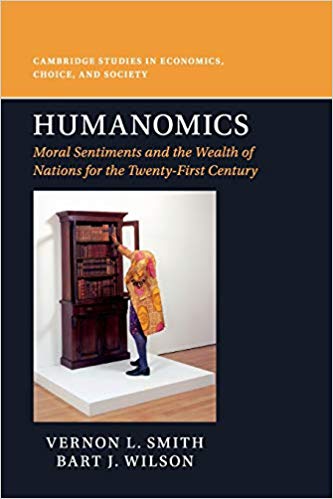Richard Godden: “Humanomics: Moral Sentiments and the Wealth of Nations for the Twenty-First Century” by Vernon L. Smith and Bart J. Wilson

Economics is a social science. It relates to the behaviour of human beings and its success as a science turns to a considerable extent upon its ability credibly to model that behaviour in such a way as to enable reliable predictions to be made.
Neoclassical economists have focused on the concept of utility maximisation as a governing model (“Mr Maximise Utility” or “Max-U”). This approach has come under sustained attack in recent years and Nobel Prize winning economist Vernon Smith and his colleague at Chapman University, Bart Wilson have been at the forefront of these attacks. Humanomics is their latest salvo. It brings together in a concise form (the book being only 207 pages long) the research and thinking that they have undertaken over the past couple of decades.
Smith and Wilson accept that Max-U “served well-enough the observational demands of decision in market supply and demand experiments under perfect enforcement of property” (page 159) but they point to its failure to account for the results of two person trust game experiments of the past 30 years. They argue that a new theoretical model of the relevant human behaviour is necessary, and they seek this in Adam Smith’s first book, The Theory of Moral Sentiments (1759). They suggest the theory put forward in that work both explains modern experimental results and has predictive force.
Most prospective readers of Humanomics will have heard of Adam Smith’s later and more famous work “An Inquiry into the Nature and Causes of the Wealth of Nations” (1776) but it is likely that few will have read The Theory of Moral Sentiments and many will question whether a largely forgotten book written over 250 years ago is worthy of resurrection. However, few will have any doubts on this score once they have read what Smith and Wilson have to say about it.
The first half of Humanomics largely comprises an explanation of the perceived problem in the concept of utility maximisation, the dismissal of previous attempts to solve that problem and a detailed analysis of Adam Smith’s theory. It includes a close examination of Smith’s terminology, which is vital since some of his key concepts are no longer in everyday use (e.g. “beneficence”) and others of them are used in a sense that does not quite correspond to some modern usage (e.g. “sentiments”). Having done this, Smith and Wilson move on to extract various axioms, assumptions and principles from Smith’s work. Some of these may seem self-evident but the reader may have a sneaking suspicion that many economists have forgotten them (e.g. “Axiom 1: Human beings fellow feel with each other”, page 71). Others are less obvious but appear to correspond with everyday experience (e.g. “Axiom 4: As compared to a normal baseline condition, human beings experience an asymmetrical change between feeling something good (e.g. joy) and feeling something bad (e.g. sorrow)”, page 73 – an axiom which is evidenced by the disconcerting fact that vendettas tend to have rather longer lives than alliances).
Smith and Wilson particularly stress Adam Smith’s concepts of “fellow feeling” and “the impartial spectator”. Quoting Deirdre McCloskey’s Bourgeoise Equality (which is reviewed on this website), they point out that we misunderstand Adam Smith if we focus solely on his concept of the invisible economic hand of the market place: Smith saw two invisible hands, the second being the social hand of the impartial spectator (pages 5-6). We are social beings and, as Adam Smith put it, “we endeavour to examine our own conduct as we imagine any other fair and impartial spectator would examine it” (page 75).
Having set out their theoretical stall, in the second half of the book, Smith and Wilson move on to summarise the results of the trust game experiments of recent years and explain them by reference to the theory. They suggest that this provides a convincing explanation of a number of the experimental observations. For example, they suggest that it explains why many people are willing to take a financial risk by trusting another person (even an unknown stranger) to “do the right thing” and why a clear majority of people, having been trusted in this way, prove trustworthy even though they could benefit financially by being selfish and even though this selfishness would never be known to anyone other than themselves. It may even explain the counter intuitive fact that the addition to the trust game of a mechanism whereby the first person can financially punish the second if they are selfish increases rather than reduces the incidence of selfish behaviour
Humanomics is a dense book that requires detailed study. It also contains a significant amount of mathematical and quasi-mathematical propositions, which will put off some readers. However, it repays careful attention, most of the maths will be understood by those who have some experience of formal logic and, since all of the key arguments are explained verbally, other readers can skip the maths without thereby losing the thread of the argument (although, in a few places, they may worry that they have missed something).
Inevitably, the book has shortcomings. For example, in places, it betrays the fact that large parts of it comprise reworked papers published previously by the authors and other collaborators (e.g. there is a lot of repetition and the end of chapter 10 reads like the climax of the book even though three more chapters follow it). More seriously, many readers will find the explanations of the experiments so compressed as to be hard to follow, at least without reading on and then referring-back to earlier parts of the book. Furthermore, the book does not explore the economic or policy implications of the experimental results and theoretical explanations advanced in it, although it contains tantalising hints of some of these (e.g. the comment that some “features of good conduct cannot be extorted, coerced or legislated”, page xv).
More seriously, whilst the authors have done an excellent job in analysing Adam Smith’s theory of moral sentiments, they have barely scratched the surface of a critique of it. Of course, at a high level, they are arguing that its predictive power suggests that is passed the test of being a good theory. However, a close examination of their experimental results suggests that the predictive value may not be as great as they would like to believe. Furthermore, they don’t examine the origins of the sentiments that Smith finds in human beings: they accept Smith’s assertions that either “they seem to have been given us by nature” (page 46) or they arise inexorably from the process of socialisation (e.g. page 74).
For some purposes, this deficiency doesn’t matter but many Christians and other theists will wish to suggest that there is a deeper, more fundamental explanation of human nature. Furthermore, the failure to examine closely the origins of human sentiments leaves open the question whether and to what extent they may be culturally relative and thus less universal than Adam Smith believed. For example, it may be that, at the very high level of generality dealt with by the axioms, principles and assumptions identified by Smith and Wilson, human sentiments are universal. However, what humans perceive to be worthy of gratitude and resentment (to quote Axiom 3, page 71) and, more generally, what is perceived to “satisfy our social impulse” (Principle 1, page 74) may vary from time to time and place to place.
Deirdre McCloskey considers the impact of changes in ideas in works such as Bourgeoise Equality and articles such as Adam Smith Did Humanomics: So should we (2016) and Max U versus Humanomics: a critique of neo-institutionalism (2015). It is clear that her theories and those of Smith and Wilson are related but it would be interesting to explore further whether, ultimately, hers are more subtle and ultimately more persuasive than those of Smith and Wilson or, for that matter, those of the great Adam Smith himself.
That said, one should not criticise a book for not being the last word on a subject or for giving rise to questions that require further attention. Humanomics is deeply thought provoking and, although not an easy read for the non-specialist, should be read by those who want to think further about human economic behaviour.
“Humanomics: Moral Sentiments and the Wealth of Nations for the Twenty-First Century” by Vernon L. Smith and Bart J. Wilson, was published in 2019 by Cambridge University Press (ISBN 978-1-316-64881-0). 207pp.
Richard Godden is a Lawyer and has been a Partner with Linklaters for over 25 years during which time he has advised on a wide range of transactions and issues in various parts of the world.
Richard’s experience includes his time as Secretary at the UK Takeover Panel and a secondment to Linklaters’ Hong Kong office. He also served as Global Head of Client Sectors, responsible for Linklaters’ industry sector groups, and was a member of the Global Executive Committee.

